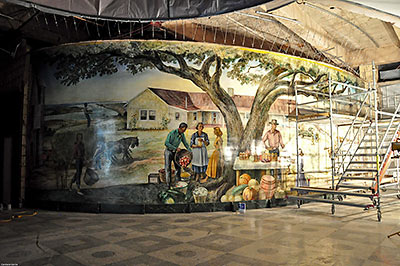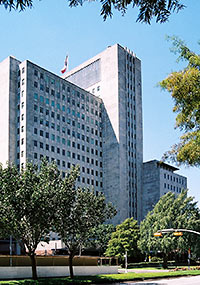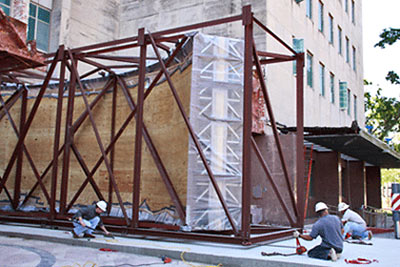
Note: Linbeck has posted a response, which we’ve now included at the bottom of this story.
 If everything goes well, the giant ranch-scene mural by artist Peter Hurd that’s stood in the lobby of the M.D. Anderson Cancer Center’s Houston Main Building at 1100 Holcombe in the Medical Center since the structure was built as a Prudential Life Insurance HQ in 1952 will likely qualify as the largest fresco painting ever moved successfully to a new location. A donor is paying more than half a million dollars for the curved 16-by-46-ft. wall painting, appraised for more than $4 million, to be dismantled, preserved, and transferred eventually to a new home in a public library in Artesia, New Mexico, where the artist once had a studio. But at this point it’s not entirely clear that the move will go well, because Linbeck, the contractor hired by the Texas Medical Center institution to manage the enterprise, has fired the mural-conservation consultant who’s been working on the job for more than a year, only days before a looming deadline: the handing over of the famous 18-story building the painting occupies to a demolition contractor.
If everything goes well, the giant ranch-scene mural by artist Peter Hurd that’s stood in the lobby of the M.D. Anderson Cancer Center’s Houston Main Building at 1100 Holcombe in the Medical Center since the structure was built as a Prudential Life Insurance HQ in 1952 will likely qualify as the largest fresco painting ever moved successfully to a new location. A donor is paying more than half a million dollars for the curved 16-by-46-ft. wall painting, appraised for more than $4 million, to be dismantled, preserved, and transferred eventually to a new home in a public library in Artesia, New Mexico, where the artist once had a studio. But at this point it’s not entirely clear that the move will go well, because Linbeck, the contractor hired by the Texas Medical Center institution to manage the enterprise, has fired the mural-conservation consultant who’s been working on the job for more than a year, only days before a looming deadline: the handing over of the famous 18-story building the painting occupies to a demolition contractor.
To move the mural, in January 2010 Linbeck hired Nathan Zakheim Associates, an art conservation firm from California, to develop a complex multi-stage process that included painting the back of the structure with resin and fiberglass and attaching it to massive trusses. Last month, the building’s entrance canopy was demolished to allow enough room for the painting’s exit. The mural was originally scheduled to be out the door before February 11th of this year. But efforts to meet that deadline were stymied by an almost two-and-half-month delay — which one source blames on the engineering firm hired by Linbeck — in the fabrication of the two 9,000-lb. curved steel trusses required for the job. After the trusses were finally delivered on January 10th, the conservator submitted a revised proposal that pushed the move-out date into the first week of March. Linbeck fired Zakheim from the job on January 20th.
“When you fire your conservator and bump up the schedule, it doesn’t mean it’s because you want to do the job right,” a source complains to Swamplot, expressing fears Linbeck will meet its original deadline for getting the mural out of the building — and damage or destroy it in the process. Linbeck would have had to pay additional fees to the conservator in order to keep him on, according to the source, and Linbeck’s contract with M.D. Anderson stipulates financial penalties for construction delays. “They re-read the contract, and the contract does not prohibit them from taking the mural out in crumbled pieces,” explains the source.
The mural was painted to illustrate Prudential Life Insurance’s motto at the time: “The Future Belongs to Those Who Prepare For It.” Linbeck has reportedly expressed confidence to M.D. Anderson and the donor that the company can manage the move successfully without the assistance of the conservator. But to do that, the company will have to overcome a couple of significant obstacles:
CONTINUE READING THIS STORY




 If everything
If everything